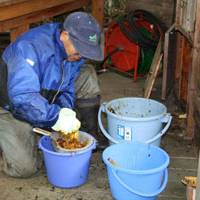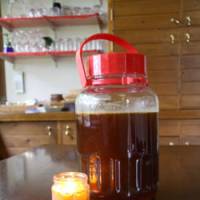In the little woods just behind my house I have a big wooden outdoor bath and a sauna, with lockers beside the sauna door for people to put their towels and clothes in.
That may sound great — but since the spring of 2008 I haven't used the sauna because wild bees decided to build a nest in one of those lockers.
I'd been away for almost a month when I came home to discover the bees, by which time comb-construction, larvae- rearing and honey-gathering were well under way.
I didn't want to disturb the bees, and neither was I willing to use the sauna and risk annoying the busy little blighters coming and going right by the door — what with me being all naked and utterly exposed to their tender mercies. So I left them and the sauna alone.
Japanese bees (Apis cerana japonica) — the honeybee subspecies native to these islands — are smaller than the imported Western bees (Apis mellifera) normally used for honey-making and pollinating in orchards and greenhouses. They don't produce as much honey, but that which they do is wonderfully sweet and fragrant.
Small as they are, Japanese bees, unlike foreign bees, have a unique way of dispatching the Japanese giant hornets (Vespa mandarinia) that sometimes try to prey on them. When a hornet scout comes to the nest, hundreds of the bees envelop it in a living, buzzing ball.
They can dislocate their wings, and by vibrating their wing muscles they can make the heat in the ball rise to about 47 degrees — enough to kill the hornet without harming the bees themselves, as they can withstand temperatures up to 50 degrees. (In winter, they keep their hives warm using the same technique.)
Japanese bees are also resistant to both a mite and a parasite that can kill Western honey bees — depradations that are causing increasing concern worldwide to honey producers and countless others who rely on bees as pollinators for crops. Tough little samurai bees indeed!
Anyhow, last year I consulted with Mr. Matsuki, our forester up here in the Nagano Prefecture hills, and he said, "Let's wait until the end of summer when they've got a lot of honey."
So I waited. Summer came and went, and when I returned from a trip to Canada I again asked Mr. Matsuki about the sauna bees. I really did fancy a good sweat, a cold plunge and an even colder beer.
"No," he said. "Can't do. There's been a great bloom of monkshood and the bees have been at it for sure. The honey will be poisonous."
Toxic honey? Monkshood (Aconitum) is a poisonous plant with pretty blue flowers that belongs to the buttercup family. Hunters I used to know in the Aleutian Islands used to crush the roots and mix the paste with fat to smear on harpoon heads in order to kill whales. I wondered just how lethal aconite honey would be, but preferred not to try it in my tea.
It made me wonder, though, how the tough little blighters can not only survive but thrive on poisonous honey. Ninja bees!
Mr. Matsuki said that if we left the bees they'd use up all the aconite honey over winter and then we would be able to remove the nest and harvest the honey this year.
In the meantime, naked sauna frolicking chez Nicol would remain off limits.
Well, the bees' nest grew until the combs half-filled the sauna locker, and we waited until the big bloom of fragrant False Acacia trees, whose nectar is a favorite of bees, was over.
Finally, in mid-June this year, Mr. Matsuki declared that it was time to harvest the honeycombs. He brought his rudimentary equipment and I donned my bee hat with its fine meshed veil and grabbed the camera. I expected Mr. Matsuki to smoke them out, but he didn't bother doing that — and even though he was stung a couple of times, he didn't seem to mind.
Instead, he cut the waxen combs away, sliced off the top layer of wax sealing the honey in, and put them into our stainless- steel centrifuge. Other combs, in which the honey was dark and treacle-thick, he simply squeezed by hand into a fine- meshed colander and let the honey drain slowly into a bucket.
Half of the combs contained bee grubs. Some of these he selected to put into a wooden hive he'd brought along with him, although he said he doubted whether the bees would take to it and would probably swarm instead and send out scouts to find a new place.
Bee, wasp and hornet grubs are considered a delicacy around here, and Mr. Matsuki gave me three combs of grubs to do as I liked with. However, these Japanese bee grubs are tiny, no bigger than a grain of rice, and it would take a couple of days to cut off the waxen lids of their hexagonal chambers and pick them out one by one with tweezers.
Instead, I dropped them into a big pot of boiling water, which separated the grubs from the wax. I got a bag full of grubs, which I took to feed the young carp in the little stock pond beside Mr. Matsuki's hut in the woods. By the time winter comes along, those carp will be fat and ready to eat.
The wax turned a deep orange-yellow color, and I skimmed it off the top of the water in the pot and remelted it. Then I got a small jar and made a string wick, weighted with a ¥5 coin and suspended from a straightened-out paper clip. I poured the wax into the jar and — lo and behold — I made a candle which gives off a gentle fragrance when burned.
The honey, meanwhile, is rich, dark, fragrant and so very, very sweet. And I'm pleased to say there's enough of this nectar from that one sauna-locker nest to last the Nicol household for the rest of the year.
Yes, I do feel a bit guilty about the bees, but just 100 meters from my house there is another large colony snug and safe under the stone monument that my neighbour erected in honor of the bears he has shot. There is also another colony in a hive box under the eaves of the thatched roof over the charcoal kiln in our Afan woods — and at least one thriving colony in an elm tree in the woods. The elm tree gets scratched and gnawed by bears, but it withstands these attacks and the bees quickly dispatch any hornet scouts that come raiding.
I read and worry about the worldwide decline of bees, but it doesn't seem to be affecting us here — and me and the bears just can't resist honey.























With your current subscription plan you can comment on stories. However, before writing your first comment, please create a display name in the Profile section of your subscriber account page.